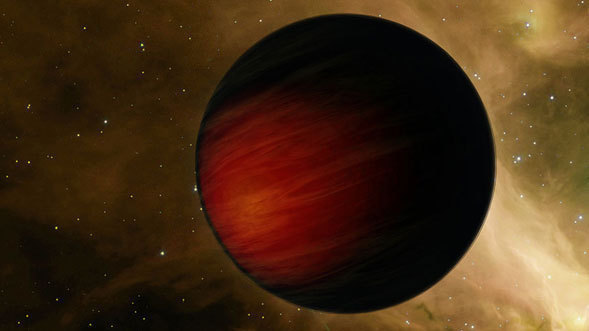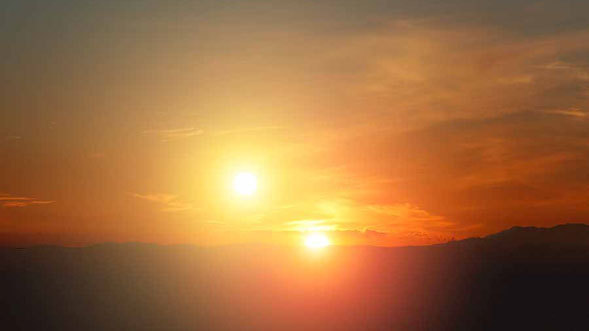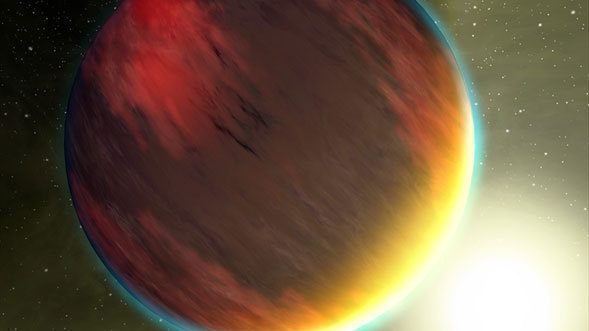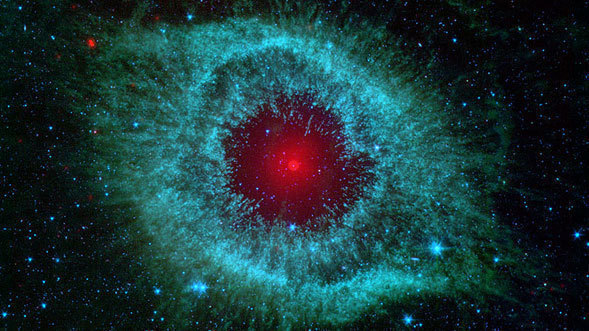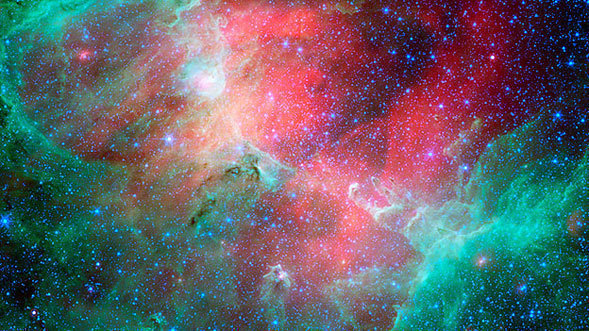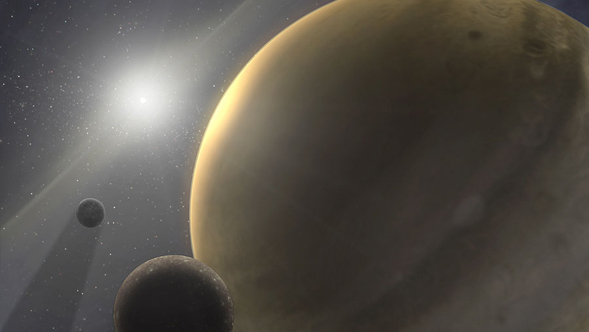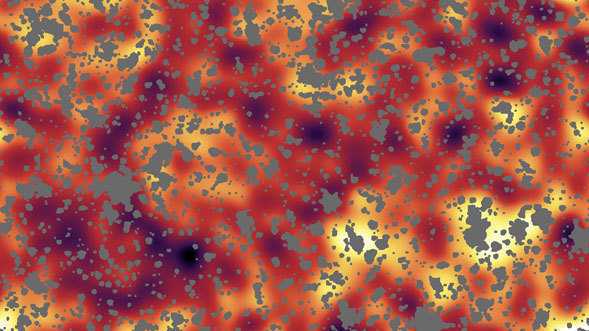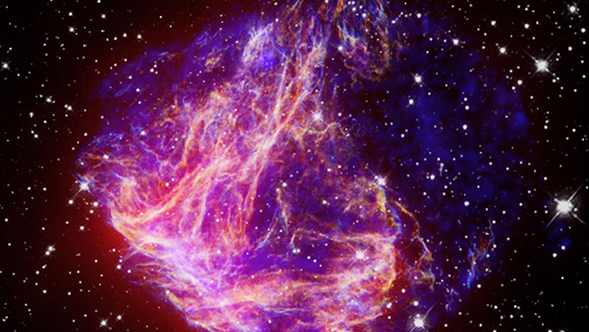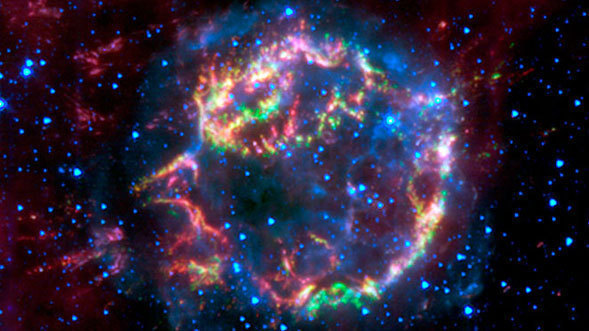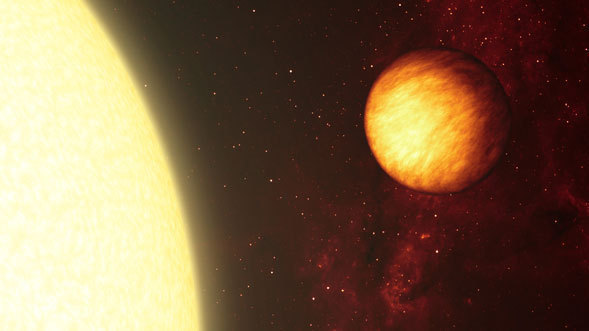Displaying news 361 - 390 of 516 in total
Astronomers now have a new "eye" for determining the distance to certain mysterious bodies in and around our Milky Way galaxy. By taking advantage of the unique position of NASA's Spitzer's Space Telescope millions of miles from Earth, and a depth-perceiving trick called parallax, they were able to pin down the most probable location of one such object. The findings will ultimately help astronomers better understand the different components of our galaxy.
An astronomer at the Spitzer Science Center has discovered three giant stellar streams arcing high over the Milky Way. Remnants of cannibalized galaxies and star clusters, the streams are between 13,000 and 130,000 light-years distant from Earth and extend over much of the northern sky. The new results are being presented by Carl Grillmair at this week's meeting of the American Astronomical Society in Honolulu, Hawaii.
In just a short amount of time, NASA's Spitzer Space Telescope has bagged thousands of previously unknown dwarf galaxies in a giant cluster of galaxies.
Large galaxy clusters are the universe's metropolises, and for years many astronomers have focused their attention on the crowded "downtowns." However, a new map of some of the largest ancient galactic cities shows that much of the "action" is happening in the cosmic suburbs.
A new image from NASA's Spitzer Space Telescope shows infant stars "hatching" in the head of Orion, the famous hunter constellation visible from northern hemispheres during winter nights. Astronomers suspect that shockwaves from a 3-million-year-old explosion of a massive star may have initiated this newfound birth.
Researchers using NASA's Spitzer Space Telescope have learned what the weather is like on two distant, exotic worlds. One team of astronomers used the infrared telescope to map temperature variations over the surface of a giant gas planet, HD 189733b, revealing it likely is whipped by roaring winds. Another team determined that the gas planet HD 149026b is the hottest yet discovered.
Rainbow-colored jets in the cosmic cloud BHR 71 point to a celestial smash occurring 600 light-years away from Earth -- and NASA's Spitzer Space Telescope provides an exclusive peek at the "jet-setting" stars inside.
Astronomers may be one step closer to understanding how the ingredients of life are processed in space, thanks to NASA's Spitzer Space Telescope.
Astronomers have laid down the cosmic equivalent of yellow "caution" tape around super hot stars, marking the zones where cooler stars are in danger of having their developing planets blasted away.
The Seven Sisters, also known as the Pleiades, seem to float on a bed of feathers in a new infrared image from NASA's Spitzer Space Telescope. Clouds of dust sweep around the stars, swaddling them in a cushiony veil.
A team of NASA scientists led by a member of the Spitzer Science Center believe they have found a way to predict the color of plants on planets in other solar systems.
Using a quartet of space observatories, University of Maryland astronomers may have cracked a 45-year mystery surrounding two ghostly spiral arms in the galaxy M106.
The double sunset that Luke Skywalker gazed upon in the film Star Wars might not be a fantasy.
For the last two years, astronomers have suspected that a nearby white dwarf star called GD 362 was "snacking" on a shredded asteroid. Now, an analysis of chemical "crumbs" in the star's atmosphere conducted by NASA's Spitzer Space Telescope has confirmed this suspicion.
NASA's Spitzer Space Telescope has captured for the first time enough light from planets outside our solar system, known as exoplanets, to identify molecules in their atmospheres. The landmark achievement is a significant step toward being able to detect possible life on rocky exoplanets and comes years before astronomers had anticipated.
A bunch of rowdy comets are colliding and kicking up dust around a dead star, according to new observations from NASA's Spitzer Space Telescope. The dead star lies at the center of the much-photographed Helix nebula, a shimmering cloud of gas with an eerie resemblance to a giant eye.
The three iconic space pillars photographed by NASA's Hubble Space Telescope in 1995 might have met their demise, according to new evidence from NASA's Spitzer Space Telescope.
Gas-giant planets like Jupiter and Saturn form soon after their stars do, according to new research.
New observations from NASA's Spitzer Space Telescope strongly suggest that infrared light detected in a prior study originated from clumps of the very first objects of the Universe. The recent data indicate this patchy light is splattered across the entire sky and comes from clusters of bright, monstrous objects more than 13 billion light-years away.
Have supermassive black holes changed since the dawn of our Universe nearly 14 billion years ago?
NASA's Great Observatories -- Spitzer, Hubble, and Chandra -- are working together to unlock the mysterious structure of a supernova remnant in a nearby galaxy.
A new image from NASA's Spitzer and Hubble Space Telescopes looks more like an abstract painting than a cosmic snapshot. The masterpiece shows the Orion nebula in an explosion of infrared, ultraviolet, and visible-light colors.
Something scary appears to be slithering across the plane of our Milky Way galaxy in this new Halloween image from NASA's Spitzer Space Telescope. The snake-like object is actually the core of a thick, sooty cloud large enough to swallow dozens of solar systems. In fact, astronomers say its "belly" may be harboring beastly stars in the process of forming.
Astronomers using NASA's infrared Spitzer Space Telescope have discovered that an exploded star, named Cassiopeia A, blew up in a somewhat orderly fashion, retaining much of its original onion-like layering.
Astronomers using NASA's Spitzer Space Telescope have recently identified two quasars, or supermassive black holes, that may be on the verge of a colossal cosmic "belch."
Mark your calendars for The Art of Astronomy, a three-day public event celebrating the collaboration of astronomy and art in Pasadena, California. The event will feature a spectacular slide show of cosmic images, lectures from world-renowned space artists, and a public unveiling of a magnificent new image from NASA's Spitzer and Hubble Space Telescopes.
NASA's Spitzer Space Telescope has made the first measurements of the day and night temperatures of a planet outside our solar system. The infrared observatory revealed that the Jupiter-like gas giant planet circling very close to its sun is always as hot as fire on one side, and potentially as cold as ice on the other.
Could all of the asteroids, comets, and planets in our Milky Way galaxy be made of a similar mix of dusty components?
A star must live in a relatively tranquil cosmic neighborhood to foster planet formation, say astronomers using NASA's Spitzer Space Telescope.
For a brief moment in 2002, an obscure star called V838 Monocerotis (nicknamed V838 Mon by astronomers) suddenly became 600,000 times brighter than our Sun and temporarily was the brightest star in our Milky Way galaxy. Within a few months, it faded back into obscurity.
Displaying news 361 - 390 of 516 in total





